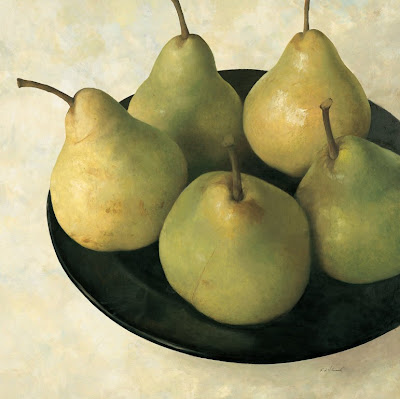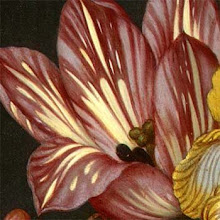Thursday, August 30, 2012
Grapes
Nicolas de Largilliere (1556-1646), Two Bunches of Grapes.
Gerard van Spaendock (1746-1822), Black grapes on a Marble Ledge.
Robert Hannaford, Australian, contemporary.
The translucency and reflectivity, the variety of colour and tone, in a bunch of grapes is challenging but provides a lot of visual interest.
Saturday, August 11, 2012
Edges: Marc-Laurent Bruyas
When the human eye looks at a scene, things at the focal point appear crisp and well-defined while things in the periphery are fuzzier and less distinct.
One of the important differences between painting and photography is that the painter can simulate the appearance of things as seen by the eye. The painter can decide what they want the viewer to pay attention to, and they can manipulate edges and contrasts in order to guide the viewer's eye around the painting.
A painting with all hard edges, or all soft edges, is visually less interesting than a painting with a variety of edges.
In the upper painting in particular, Bruyas has left the periphery of the composition fuzzier or blurrier than the blooms in the centre.
"lost edges" are parts of the painting where the edge between two objects disappears because the tonal values and colours of the adjacent areas become very close. The objects open out into each other, forming a larger shape, and this adds visual interest to the composition.
In the lower painting the pink roses have a lost edge between them, while a dark leaf provides greater separation between the two white roses. There are also lost edges where the dark leaves are close in value to the shadows on the ground underneath.
A still life painter will often push tonal values up or down in order to create lost edges. This is not dishonest; it is merely simulating what the eye does.
Saturday, August 4, 2012
Fabrice de Villeneuve
In Asian art, words have long been combined with images as an integral part of painting composition.
The Cubists introduced text, usually in the form of newsprint, into their still life works, giving them a look suggestive of graphic design .
Don't be afraid to use blacks and browns in a still life painting, but make them interesting. An all neutral painting will need a feature note of red or some other warm colour somewhere to give it life.
This was often provided by the vermillion stamp in Chinese paintings.
Juan Gris, Still Life in Front of the Window.
Subscribe to:
Posts (Atom)















+Still+Life+with+Roses,+14+x+10+in.jpg)









